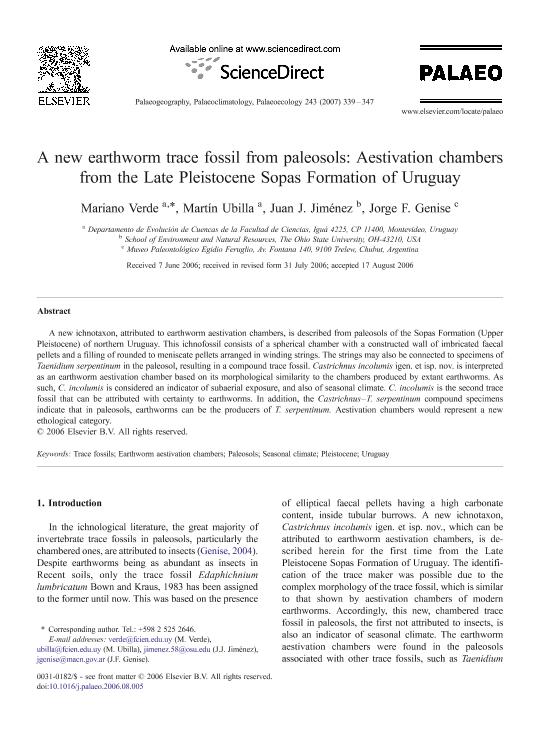Artículo
A new earthworm trace fossil from paleosols: Aestivation chambers from the Late Pleistocene Sopas Formation of Uruguay
Fecha de publicación:
01/2007
Editorial:
Elsevier Science
Revista:
Palaeogeography, Palaeoclimatology, Palaeoecology
ISSN:
0031-0182
Idioma:
Inglés
Tipo de recurso:
Artículo publicado
Clasificación temática:
Resumen
A new ichnotaxon, attributed to earthworm aestivation chambers, is described from paleosols of the Sopas Formation (Upper Pleistocene) of northern Uruguay. This ichnofossil consists of a spherical chamber with a constructed wall of imbricated faecal pellets and a filling of rounded to meniscate pellets arranged in winding strings. The strings may also be connected to specimens of Taenidium serpentinum in the paleosol, resulting in a compound trace fossil. Castrichnus incolumis igen. et isp. nov. is interpreted as an earthworm aestivation chamber based on its morphological similarity to the chambers produced by extant earthworms. As such, C. incolumis is considered an indicator of subaerial exposure, and also of seasonal climate. C. incolumis is the second trace fossil that can be attributed with certainty to earthworms. In addition, the Castrichnus-T. serpentinum compound specimens indicate that in paleosols, earthworms can be the producers of T. serpentinum. Aestivation chambers would represent a new ethological category.
Archivos asociados
Licencia
Identificadores
Colecciones
Articulos(CCT-CENPAT)
Articulos de CTRO.CIENTIFICO TECNOL.CONICET - CENPAT
Articulos de CTRO.CIENTIFICO TECNOL.CONICET - CENPAT
Citación
Verde, Mariano; Ubilla, Martín; Jiménez, Juan J.; Genise, Jorge Fernando; A new earthworm trace fossil from paleosols: Aestivation chambers from the Late Pleistocene Sopas Formation of Uruguay; Elsevier Science; Palaeogeography, Palaeoclimatology, Palaeoecology; 243; 3-4; 1-2007; 339-347
Compartir
Altmétricas




